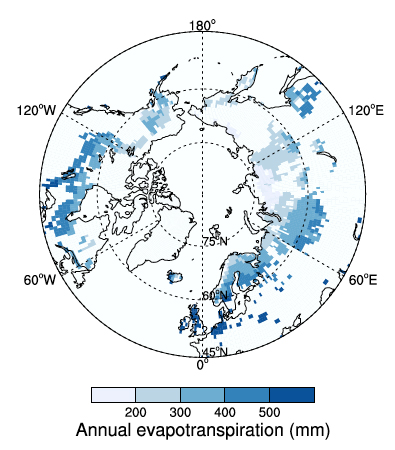Lund-Potsdam-Jena Wetland Hydrology and Methane DGV Model (LPJ-WHyMe v1.3.1)
Access & Use Information
Downloads & Resources
-
Google Scholar search resultsHTML
Search results for publications that cite this dataset by its DOI.
-
Download this datasetHTML
This link allows direct data access via Earthdata login
-
View documentation related to this datasetHTML
ORNL DAAC Data Set Documentation
-
This dataset's landing pageHTML
Data set Landing Page DOI URL
-
View documentation related to this datasetHTML
Data Set Documentation
-
View documentation related to this datasetPDF
Data Set Documentation
-
View documentation related to this datasetHTML
Data Set Documentation
-
View documentation related to this datasetPDF
Data Set Documentation
-
View documentation related to this datasetHTML
Data Set Documentation
-
View documentation related to this datasetHTML
Data Set Documentation
-
Get a related visualizationJPEG
Annual evapotranspiration for peatland grid cells simulated with LPJ-WHy,...
-
Landing PageLanding Page
Dates
| Metadata Created Date | November 12, 2020 |
|---|---|
| Metadata Updated Date | December 6, 2023 |
Metadata Source
- Data.json Data.json Metadata
Harvested from NASA Data.json
Graphic Preview

Additional Metadata
| Resource Type | Dataset |
|---|---|
| Metadata Created Date | November 12, 2020 |
| Metadata Updated Date | December 6, 2023 |
| Publisher | ORNL_DAAC |
| Maintainer | |
| Identifier | C179002979-ORNL_DAAC |
| Data First Published | 2013-04-09 |
| Language | en-US |
| Data Last Modified | 2023-03-11 |
| Category | Model Archive, geospatial |
| Public Access Level | public |
| Bureau Code | 026:00 |
| Metadata Context | https://project-open-data.cio.gov/v1.1/schema/catalog.jsonld |
| Metadata Catalog ID | https://data.nasa.gov/data.json |
| Schema Version | https://project-open-data.cio.gov/v1.1/schema |
| Catalog Describedby | https://project-open-data.cio.gov/v1.1/schema/catalog.json |
| Citation | Wania, R., I. Ross, and I.C. Prentice. 2013. Lund-Potsdam-Jena Wetland Hydrology and Methane DGV Model (LPJ-WHyMe v1.3.1). ORNL DAAC, Oak Ridge, Tennessee, USA. http://dx.doi.org/10.3334/ORNLDAAC/1150 |
| Graphic Preview Description | Annual evapotranspiration for peatland grid cells simulated with LPJ-WHy, averaged over 1991-2000 using the CRU TS 2.1 data set. |
| Graphic Preview File | https://daac.ornl.gov/MODELS/guides/LPJ_WhyMe_evapotranspiration_fig2.jpg |
| Harvest Object Id | 2f833bb0-cd87-421a-9916-1b2427603b15 |
| Harvest Source Id | 58f92550-7a01-4f00-b1b2-8dc953bd598f |
| Harvest Source Title | NASA Data.json |
| Homepage URL | https://doi.org/10.3334/ORNLDAAC/1150 |
| Metadata Type | geospatial |
| Old Spatial | -180.0 -60.0 180.0 90.0 |
| Program Code | 026:001 |
| Source Datajson Identifier | True |
| Source Hash | 99e626d91a65b1eded8e5e1fe868dd2ddda4b4017fdfd230c76a32055f3beda7 |
| Source Schema Version | 1.1 |
| Spatial | |
| Temporal | 1972-01-01T00:00:00Z/2010-10-15T23:59:59Z |
Didn't find what you're looking for? Suggest a dataset here.

